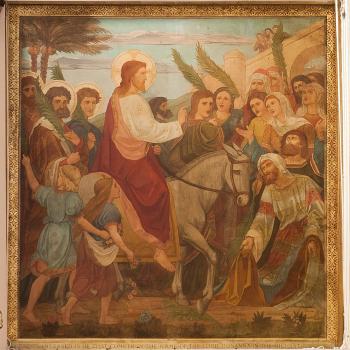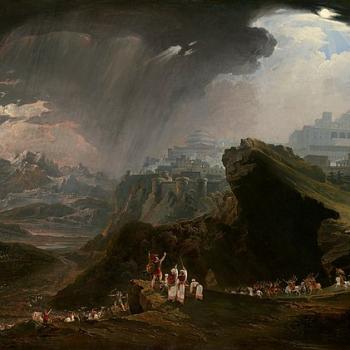On Sunday evening, the Dawson Creek Church of the New Jerusalem held their annual Christmas tableaux service – the first I’ve participated in as resident pastor. “Tableaux” is short for “tableaux vivants,” meaning “living pictures.” In a tableau vivant, the actors stand completely still to form a still picture; when it’s done well, it can almost look like a three-dimensional photograph. The service this year here in Dawson Creek was simple and beautiful. The woman organizing it had a vision of something that would create a space for peaceful reflection, a place for calm in the busy Christmas season. At the front of the church we hung a dark blue curtain. All the costumes and props were bright white, and the only light came from some soft blue flood lights in the corners and a bright white spotlight. The effect of the white against the blue was beautiful. For the final scene, we opened the curtain to reveal an open copy of the Lord’s Word, sitting on the altar, with lit candles beside it and a light shining down on it; and I read out the opening passages of the gospel of John: “In the beginning was the Word…”
Churches everywhere put on Christmas pageants, but Christmas tableaux seem to be a special tradition of the New Church, and especially the General Church, the denomination that I belong to. I’m not sure the reason for this; doing a little research in “New Church Life” magazine, I found that New Church congregations have been having Christmas tableaux services as far back as 1884 – which is about as far back as the New Church Life records go. It seems that tableaux were much more common everywhere at the time; but while they faded throughout the rest of America, they became a tradition in New Church congregations.
I remember going to the tableaux as a kid and feeling that they were magical; the actors stood so still that when I was very little I remember sometimes wondering if they were real people or statues. My images of the advent are drawn primarily from three sources, I think: my family’s nativity crèche; the book The Christ Child, illustrated by Maud and Miska Petersham; and the Christmas tableaux in my hometown Bryn Athyn, PA. During my early childhood, they were held on the stage at the school; in more recent years, they’ve happened on the chancel at the cathedral. They now incorporate some live action as well as still scenes, but they still retain some of that magical quality. This year they were streamed online and archived; you can see them here (starts at 6:50).
I think one big reason that the tableaux were so powerful for me as a kid was that they were so different from almost everything else I experienced day-to-day. In a world of constant bustle, nothing is more striking than total stillness. The tableaux (as I remember them, anyway) were an example of the truth that church doesn’t become special by mimicking entertainment culture; even for kids, church is special when it provides an oasis of calm, of peace, of reverence: a place where magic can happen.
That kind of reverence that a child can experience is difficult to describe, but it’s precious. I love this description from Conjugial Love of the way little children are taught in heaven:
Little children once represented the Lord rising from the tomb, and together with it the union of His Humanity with the Divine. They presented first an idea of the tomb, but not at the same time an idea of the Lord, except so remotely that one scarcely perceived that it was the Lord, and then only as though at a distance, the reason being that in the idea of a tomb there is something funereal, which they thus removed. Afterwards they carefully let into the tomb some sort of atmosphere, yet having the appearance of a thin watery mist, by which they symbolized, also by an appropriate remoteness, the spiritual life in baptism. Later I saw represented by them the Lord’s going down to those who were bound, and His ascent with the bound into heaven. And, in typically childlike fashion, they let down delicate and fine little threads, almost invisible, by which to raise the Lord in His ascent, governed always by a holy fear lest anything in the representation touch on any point in which there was not something heavenly. (Conjugial Love 412)
I think that Christmas tableaux, when they are done well, can contain the same kind of tender reverence and care that that passage describes. And the simplest tableaux service, when done with that kind of care, can leave a much longer-lasting impression on a child than the flashiest, funniest, most impressive theatrical production. I know, because it did for me. Maybe it seems like I’m over-idealizing my childhood, and maybe I am a little (it’s easy to do this time of year). There were probably years when I was bored or unimpressed with the tableaux. But I do clearly remember that on the whole, the tableaux were one of the things I looked forward to most at Christmastime.















